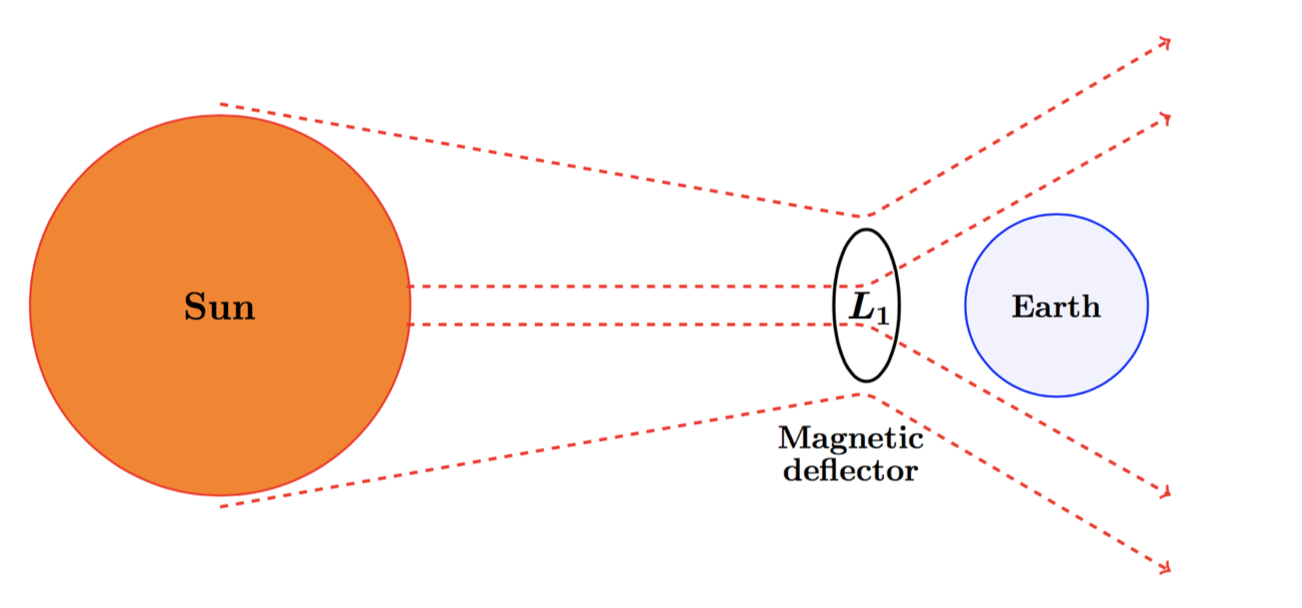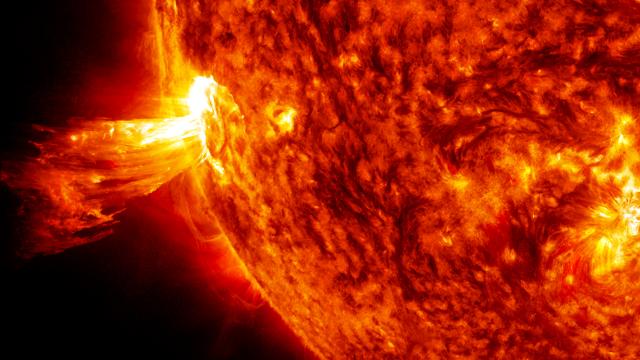Every 100 years or so, our Sun gives off a great big belch that sends an intense wave of charged particles towards Earth. This wasn’t a problem in the past, but our high-tech civilisation is now disturbingly vulnerable to these solar storms. A new study quantifies the economic risks posed by these extreme solar storms, while also proposing a super-futuristic solution to the problem: An Earth-sized shield built in outer space.
Image: NASA
The term “solar storm” is used to identify the various nasties the Sun can hurl our way, including X-rays, charged particles and magnetised plasma. In 1859, a series of powerful coronal mass ejections (CMEs) hit our planet head on, disrupting telegraph stations and causing widespread communication outages. If we were to be hit by an equally powerful solar storm today, it would knock out satellites and electrical grids, disrupting global communications, transportation and supply chains. Total worldwide losses could reach up to $US10 trillion ($13 trillion), with recovery taking many years.
We have no idea when the next Carrington-like event will occur, but a 2012 paper proposed a 10 per cent chance of one happening in the next decade. Indeed, like an earthquake-prone city built above a pair of conflicting fault lines, it’s only a matter of time before our planet is hit by the next Big One. And to make matters worse, we’re becoming increasingly vulnerable to these events owing to steady technological advances.
A new paper by Manasvi Lingam and Avi Loeb from Harvard-Smithsonian Center for Astrophysics is the first to consider the economic impacts of a sizeable solar storm in the future, when our reliance on technology is far greater than it is today. In addition, the authors propose a strategy to mitigate the effects — and they aren’t thinking small. Lingam and Loeb say we should construct a massive shield in space, and that the costs would be far lower than having to deal with the aftermath of a solar storm. The researchers go on to argue that advanced extraterrestrial civilisations have likely done this already, and that we should search for these shields as a way to detect aliens.
The new paper is currently being considered for publication in The Astrophysical Journal Letters.
To help them with their economic model, Lingam and Loeb factored in two important assumptions. First, the longer the duration between powerful solar flares, the more powerful they will be. Second, our civilisation will experience exponential growths in technology and Gross Domestic Product (GDP) in the coming decades.
“We predict that within about 150 years, there will be an event that causes damage comparable to the current United States’ GDP of approximately $20 trillion [$AU25.5 trillion], and the damage will increase exponentially at later times until technological development will saturate [that is, when technological development finally starts to slow down and be globally distributed],” Loeb told Gizmodo. “Such a forecast was never attempted before.”
With these potentially catastrophic losses in mind, Lingam and Loeb turn to potential solutions. Unsurprisingly, the proposed mitigation strategies aren’t subtle, but of the three solutions considered, only one was deemed viable by the researchers.
“[Some] shielding solutions rely on placing physical object(s) between the Earth and the Sun. This would not work since the mass will be tremendous and can block the sunlight,” Lingam told Gizmodo. “Similarly, one can use electrical fields instead of magnetic fields. However, the problem is that the electrical field will repel positive particles but will attract the negative particles. Hence, we suggest that magnetic shielding is relatively the most viable.”

An illustration of the proposed magnetic deflector (not drawn to scale). (Image: Lingam and Loeb, 2017)
This Earth-sized “magnetic deflector” would be placed at the Lagrange L1 point between the Earth and the Sun at a distance of about 329,000km from our planet’s surface. It would act as a current loop, and deflect the Sun’s harmful particles back into space. The researchers say the required amount of deflective force is relatively small, and that we already have much of the technology required to make this possible. The big challenge, they say, will be to scale it up to its superstructural size.
“The related engineering project could take a few decades to construct in space,” said Loeb. “The cost for lifting the needed infrastructure to space (weighing 100,000 tons) will likely [cost around] hundreds of billions of dollars, much less than the expected [solar storm] damage over a century.”
The authors say the price of the magnetic deflector is comparable to the total cost of the International Space Station, and that it’s about three to four orders of magnitude cheaper than the current global GDP — or the economic damage from a flare in about a hundred years time. But that’s if we use material from Earth. It may make more economic sense to build the superstructure using materials extracted from the asteroid belt.
“I agree completely that the risk and economic damage from solar eruptions is too large and should be mitigated — imagine the current situation in Puerto Rico but worldwide,” said Anders Sandberg, a research fellow who works out of Oxford University’s Future of Humanity Institute, a part of the Oxford Martin School, in an interview with Gizmodo. “However, I was not convinced by their economic model at all… there seemed to be far too many arbitrary assumptions. In particular, the vulnerability of the world economy can both increase and decrease, for example, if we build a more modularised and resilient power grid.”
As for the prescribed solution — the magnetic deflector — Sandberg says it’s basically a “backup magnetic field,” and, as a megascale engineering problem, “not too daunting.”
“Just an Earth-sized loop of one-centimeter thick copper wire weighing 100,000 tons and presumably powered by a 1 TW solar power farm [should do it],” said Sandberg, who wasn’t involved in the new study. “It does not seem to be that far away from what we can currently do (except for that solar power farm). But it is not going to be as cheap as they calculated since the big cost is likely the energy system and installation, not the wiring. Now, reducing solar eruption risk is worth a lot, but I doubt this on its own will be cost-effective. As part of space industrialisation, yes (especially since it is extra vulnerable), but otherwise I suspect smarter power-grids give more safety per dollar.”
Sandberg’s concerns notwithstanding, a gigantic magnetic deflector makes a lot of sense, particularly for a technological civilisation considerably more advanced than our own. And in fact, it’s conceivable that some hypothetical alien civilisations have done this already. It would be wise, argue Loeb and Lingam, for us to search for signs of these shields as a way to detect extraterrestrial civilisations. We could do it using the transit method, the exoplanet detection technique that aims to observe such objects when they eclipse their host stars from our vantage point here on Earth.
“The [resulting] imprint could be changes in the brightness of the host star due to occultation (similar behaviour to Tabby’s star) if the structure is big enough,” said Loeb. “The situation could be similar to Dyson spheres, but instead of harvesting the energy of the star [as a Dyson sphere hypothetically would], the purpose of the infrastructure is to protect a technological civilisation on a planet from the flares of its host star.”
Andrew Siemion, Director of Berkeley SETI Research Center and Principal Investigator at the Breakthrough Listen program, says our deep dependence on electronics has created a particular susceptibility to stellar flare events, and that Loeb and Lingam have the right idea.
“Indeed we might some day attempt to mitigate these events using large scale ‘astroengineering’, and under certain circumstances these structures could be detectable at interstellar distances,” Siemion told Gizmodo. “This is a fascinating thought experiment, and is exactly the kind of thinking that SETI scientists must continually engage in as we seek to identify technologies in the widest variety of incarnations.”
The authors of the new study are right to raise the prospect of solar storms as an important public issue. When it comes to mitigating existential or catastrophic natural hazards, our attention tends to be focused on asteroid impacts. The trouble is, solar storms happen with far greater frequency, so it would be a good idea to start thinking about mitigation strategies pretty much immediately. A solar deflector may be a sensible solution (eventually), but as Sandberg points out, it would also be smart to build a technological infrastructure that’s immune to the Sun’s harmful flares. The more angles we use to approach this problem, the better.
[A pre-print of this paper is available at arXiv]
